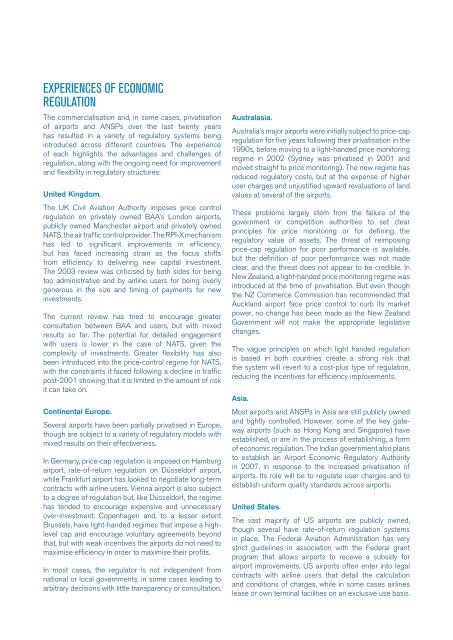Economic Regulation - IATA
Economic Regulation - IATA
Economic Regulation - IATA
You also want an ePaper? Increase the reach of your titles
YUMPU automatically turns print PDFs into web optimized ePapers that Google loves.
Experiences of <strong>Economic</strong><br />
<strong>Regulation</strong><br />
The commercialisation and, in some cases, privatisation<br />
of airports and ANSPs over the last twenty years<br />
has resulted in a variety of regulatory systems being<br />
introduced across different countries. The experience<br />
of each highlights the advantages and challenges of<br />
regulation, along with the ongoing need for improvement<br />
and flexibility in regulatory structures:<br />
United Kingdom.<br />
The UK Civil Aviation Authority imposes price control<br />
regulation on privately owned BAA’s London airports,<br />
publicly owned Manchester airport and privately owned<br />
NATS, the air traffic control provider. The RPI-X mechanism<br />
has led to significant improvements in efficiency,<br />
but has faced increasing strain as the focus shifts<br />
from efficiency to delivering new capital investment.<br />
The 2003 review was criticised by both sides for being<br />
too administrative and by airline users for being overly<br />
generous in the size and timing of payments for new<br />
investments.<br />
The current review has tried to encourage greater<br />
consultation between BAA and users, but with mixed<br />
results so far. The potential for detailed engagement<br />
with users is lower in the case of NATS, given the<br />
complexity of investments. Greater flexibility has also<br />
been introduced into the price-control regime for NATS,<br />
with the constraints it faced following a decline in traffic<br />
post-2001 showing that it is limited in the amount of risk<br />
it can take on.<br />
Continental Europe.<br />
Several airports have been partially privatised in Europe,<br />
though are subject to a variety of regulatory models with<br />
mixed results on their effectiveness.<br />
In Germany, price-cap regulation is imposed on Hamburg<br />
airport, rate-of-return regulation on Düsseldorf airport,<br />
while Frankfurt airport has looked to negotiate long-term<br />
contracts with airline users. Vienna airport is also subject<br />
to a degree of regulation but, like Düsseldorf, the regime<br />
has tended to encourage expensive and unnecessary<br />
over-investment. Copenhagen and, to a lesser extent<br />
Brussels, have light-handed regimes that impose a highlevel<br />
cap and encourage voluntary agreements beyond<br />
that, but with weak incentives the airports do not need to<br />
maximise efficiency in order to maximise their profits.<br />
In most cases, the regulator is not independent from<br />
national or local governments, in some cases leading to<br />
arbitrary decisions with little transparency or consultation.<br />
Australasia.<br />
Australia’s major airports were initially subject to price-cap<br />
regulation for five years following their privatisation in the<br />
1990s, before moving to a light-handed price monitoring<br />
regime in 2002 (Sydney was privatised in 2001 and<br />
moved straight to price monitoring). The new regime has<br />
reduced regulatory costs, but at the expense of higher<br />
user charges and unjustified upward revaluations of land<br />
values at several of the airports.<br />
These problems largely stem from the failure of the<br />
government or competition authorities to set clear<br />
principles for price monitoring or for defining the<br />
regulatory value of assets. The threat of reimposing<br />
price-cap regulation for poor performance is available,<br />
but the definition of poor performance was not made<br />
clear, and the threat does not appear to be credible. In<br />
New Zealand, a light-handed price monitoring regime was<br />
introduced at the time of privatisation. But even though<br />
the NZ Commerce Commission has recommended that<br />
Auckland airport face price control to curb its market<br />
power, no change has been made as the New Zealand<br />
Government will not make the appropriate legislative<br />
changes.<br />
The vague principles on which light handed regulation<br />
is based in both countries create a strong risk that<br />
the system will revert to a cost-plus type of regulation,<br />
reducing the incentives for efficiency improvements.<br />
Asia.<br />
Most airports and ANSPs in Asia are still publicly owned<br />
and tightly controlled. However, some of the key gateway<br />
airports (such as Hong Kong and Singapore) have<br />
established, or are in the process of establishing, a form<br />
of economic regulation. The Indian government also plans<br />
to establish an Airport <strong>Economic</strong> Regulatory Authority<br />
in 2007, in response to the increased privatisation of<br />
airports. Its role will be to regulate user charges and to<br />
establish uniform quality standards across airports.<br />
United States.<br />
The vast majority of US airports are publicly owned,<br />
though several have rate-of-return regulation systems<br />
in place. The Federal Aviation Administration has very<br />
strict guidelines in association with the Federal grant<br />
program that allows airports to receive a subsidy for<br />
airport improvements. US airports often enter into legal<br />
contracts with airline users that detail the calculation<br />
and conditions of charges, while in some cases airlines<br />
lease or own terminal facilities on an exclusive use basis.

















